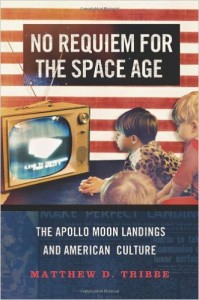Matthew D. Tribbe, No Requiem for the Space Age: The Apollo Moon Landings and American Culture (New York: Oxford University Press, 2014) 276 pages.
Reviewed by Drew Maciag
Matthew Tribbe’s engaging and highly readable No Requiem for the Space Age tells two interconnected stories in parallel. The tangible tale in the foreground is about NASA’s mission to beat Soviet cosmonauts to the moon and the subsequent winding down of that ambitious program; the less-tangible drama in the background (the one that will be of greater interest to intellectual/cultural historians) concerns the climax and ultimate decline of America’s faith in techno-rationality. By the time Apollo 11 splashed down in the Pacific in 1969, the modernization ideal that had been so ascendant just a few years earlier when John F. Kennedy launched the “space race” had already been undermined by its fallibility in the face of racism, poverty, alienation, injustice, pollution, and war—among other earthly considerations.
While Tribbe’s book unfolds on two levels narratively it operates on three wavelengths methodologically. The first is retro-journalism: telling readers what happened, when it happened, and how. This plotline involves spacecraft, the men who designed and flew them, the political and public relations struggles required to build and launch them, and especially the particulars of the signal Apollo missions. The second method is conventional intellectual analysis; here the effort shifts to explaining the ways in which  various Americans thought and wrote about what was going on, and how events outside the space program altered common perceptions of Apollo. The third approach is cultural. Tribbe locates examples of movies, novels, popular songs, and other artistic or entertainment vehicles that seemed to indicate a predominantly skeptical or ambivalent or at least ambiguous attitude toward science and space travel.
various Americans thought and wrote about what was going on, and how events outside the space program altered common perceptions of Apollo. The third approach is cultural. Tribbe locates examples of movies, novels, popular songs, and other artistic or entertainment vehicles that seemed to indicate a predominantly skeptical or ambivalent or at least ambiguous attitude toward science and space travel.
Tribbe begins by setting the record straight. Citing opinion polls and newspaper and magazine articles, he demonstrates that after the initial enthusiasm of the Kennedy era public support for the space program was never all that solid and public fascination with the astronauts’ adventures relied on rare spectacular events (Apollo 8 circling the moon, Apollo 11 landing there, Apollo 13 surviving an explosion); particularly after the mid-1960s—the moment Tribbe correctly judges to mark the end of the Space Age—many Americans preferred alternative ways to spend NASA’s huge budget. After the first moon landing in the late 1960s public interest quickly waned and government funding dropped. Only after the nostalgic patriotism and the space shuttle flights of the Reagan years did NASA return to favor; even then public support remained fickle and earlier plans for manned missions to Mars or for permanent lunar stations were abandoned.
The rise and fall of America’s manned space program was not explainable solely by the nation’s Cold War victory over bragging rights to the moon. Rather, NASA’s fortunes rose and fell along with America’s modern postwar consensus, which depended on certain tacit beliefs about government’s purpose, economic performance, social conditions, the value of scientific technology, the role of experts, and the expectation (and definition) of progress. Such beliefs composed the climate of opinion within which NASA originally thrived; once that climate became more contested, NASA starved. Tribbe’s research into the transformation of the intellectual landscape is the most valuable component of his book. By contrast, the nuts-and-bolts of the Apollo missions are (by the author’s expressed intention) not the chief focus of his study, and the purely cultural material is less substantial than the intellectual—it performs an essentially supporting (and colorizing) role.
One sign of the growing divide between defenders of the technocratic order and its (predominantly youthful) critics surfaced in a 1970 commencement address by NASA administrator Thomas Paine, in which he contrasted the constructive accomplishments of “Squareland” with the destructive antics of “Potland.” Squareland had “faith in reason,” it accepted “as true only rational facts and theories which predict future events.” Squareland’s methods alone made “crops yield, lights light, bridges carry loads, children avoid polio, and men walk on the moon.” Potland’s “truth” was “subjective and aesthetic” and “oriented to individual emotional perception.” It was “ridiculous” and “dangerous,” and unlike NASA (which looked outward with telescopes and space probes) it looked “inward” with “mystical visions” and “astrological divinations” (135-36). Potlanders could never send men to the moon. Nevertheless Paine’s technocratic defense missed something essential. In Tribbe’s judgment, despite “its immediate excitement, Apollo seemed to lack any deeper, longer-lasting meaning for humanity.” It “lacked [a] sense of wonder,” and “was not quite magical” (185). Although the space race began in the Space Age it ended in the Age of Aquarius. Ultimately a popular “neo-romantic” or counter-cultural quest for spiritual uplift contributed to modern technocracy’s decline (202). So did more mundane factors: the Vietnam War deservedly gets its share of the blame.
No Requiem for the Space Age is an informative and often thought-provoking book, even if its overall message about the destruction of consensus and the dimmed prospects for ambitious collective efforts in America is disheartening and perhaps a bit depressing (then again, how many books with “requiem” in their titles turn out to be cheerful?). I recommend this book while also noting that it is a well-told version (from a novel vantage point) of a familiar story; both the Apollo program and the breakdown of postwar culture—including the deterioration of rationality and of faith in large government initiatives—have been assessed elsewhere and often. Tribbe’s unique contributions to these topics stem from the specific evidence he has uncovered from NASA’s history collection and similar repositories such as the Smithsonian Air and Space archives. His discoveries flesh out rather than revise existing scholarship, yet they are valuable additions to it. I offer two parting observations more to stimulate thought and discussion about this book than to detract from its accomplishments:
It may merely be a matter of personal taste, but I felt that certain of the cultural examples impeded rather than illuminated the book’s argument. Right from the start, Tribbe’s page-one invocation of The Night of the Living Dead seems ham-handed and not as relevant as he claims. (Possibly this was intended as a literary device to hook readers with an entertaining opening, yet the book is interesting enough without such tricks.) Likewise much of the other cultural evidence is subject to myriad interpretations (or at least to differing emphasis). If the book was entirely cultural history Tribbe might have examined these complexities better; as actually presented many items are mentioned more or less in passing and almost appear to be window dressing.
Finally, though the word “modern” (or its variations) slips by occasionally in the text, Tribbe grants it no special due (perhaps because its meaning can be controversial); yet if applied in the “modernizing” context that fostered the technocratic-rationality of the Space Age (where modern was the ideal, modernization the process, and modernity the result), it provides a more comprehensive term for capturing the intellectual spirit that inspired American space exploration than the word “rational” (or its variations) does. The Apollo program was a self-conscious, historically propelled mission. Scientific rationality was a key component, but so was political idealism, perfection of the nation-state, integration with new communications media, construction of a New Era mentality, and the vindication of a democratic-meritocratic social order. Once these conceits lost their hegemony, Apollo lost its allure.
Drew Maciag is author of Edmund Burke in America (2013); he is currently working on two book projects, tentatively entitled : “John F. Kennedy and the Quest for Modernity,” and “Too Much of Nothing: America in the 1970s.”
: “John F. Kennedy and the Quest for Modernity,” and “Too Much of Nothing: America in the 1970s.”

One Thought on this Post
S-USIH Comment Policy
We ask that those who participate in the discussions generated in the Comments section do so with the same decorum as they would in any other academic setting or context. Since the USIH bloggers write under our real names, we would prefer that our commenters also identify themselves by their real name. As our primary goal is to stimulate and engage in fruitful and productive discussion, ad hominem attacks (personal or professional), unnecessary insults, and/or mean-spiritedness have no place in the USIH Blog’s Comments section. Therefore, we reserve the right to remove any comments that contain any of the above and/or are not intended to further the discussion of the topic of the post. We welcome suggestions for corrections to any of our posts. As the official blog of the Society of US Intellectual History, we hope to foster a diverse community of scholars and readers who engage with one another in discussions of US intellectual history, broadly understood.
Historians (some, at any rate) love to single out “the breakdown of consensus” in the turmoil of the ’60s as the explanation for a lot of things that I wonder whether it really explains to the extent supposed. Were the budgets for basic scientific and medical research cut as much as NASA’s after the mid-60s? Perhaps the space program was an easy target for cuts precisely because it had been so visible and the moon landings felt, to the public, like the culmination of a project?
The career of the admittedly fuzzy notion of “modernization” seems to have been more cyclical than a story of straight decline, or at least a decent argument for that view can be made. The word “modernization” fell out of favor but, to take one example, “nation-building” is a lot like modernization under a different name. Michael Latham argued basically that in The Right Kind of Revolution (2011). (I did a post on it on my blog a while back.)